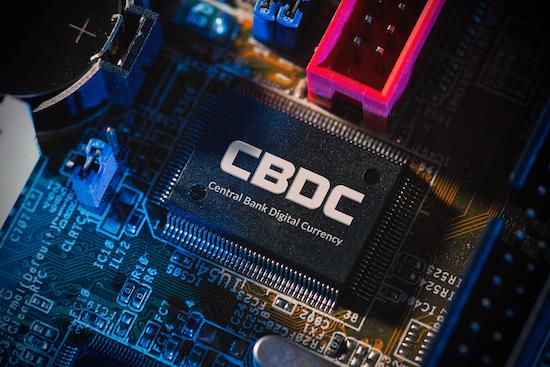CBDCs – miracle money or new world order?
Central bank digital currencies (CBDCs) promise to revolutionise money, do away with cash, hamstring crime, boost financial inclusion and drive efficiencies.

Could CBDCs be the future of money?
For those who don’t know, this wonderous new development is essentially digital coins issued by a central bank that are pegged to a country’s fiat currency (government-issued physical money). Basically, a stablecoin for banks and businesses.
According to Juniper Research, the value of payments via CBDCs will reach $213 billion a year by 2030. That value currently stands at $100 million in 2023. That’s a 260,000% increase in seven years, to put that in some sort of perspective.
This latest iteration of money, a system humans conjured up in around 3,000 BC in Sumer, according to Yuval Noah Harari (coins date back to around 650 to 600 BC), is currently being explored by nine out of ten central banks across the world in some form or another.
For governments, the appeal is clear. No cash, no organised crime. But no cash also means no privacy. For governments, that may not be a big deal. For the rest of us, it should be a major concern.
According to the International Monetary Fund (IMF), CBDCs could “accumulate sensitive payment and user data at an unprecedented scale”. This data could be used to “spy on citizens’ private transactions, obtain security-sensitive details about individuals and organisations, and even steal money”. Wow, if the IMF is concerned…
And privacy is not the only thing CBDCs could do away with. The freedom to buy, sell and travel could all be curtailed with this technology infrastructure. In theory, a central bank or government would have all the tools necessary to “switch off” someone’s ability to spend money. This sort of ‘programmable money’ should be a concern to all.
Penny for your thoughts?
The Digital Pound Foundation’s operational and governance lead and chief risk officer (CRO), Claire Conby, says: “As both public and private sector research and explorations continue to delve into the design principles and attributes of these new forms of digital money, there is one topic that repeatedly raises its head as a core discussion point – and, for many, an essential feature: privacy.”

Digital Pound Foundation CRO Claire Conby
Unlike cash, digital payments leave a breadcrumb trail. “The potential for personal information connected to this activity to be made available beyond its intended use leads to significant privacy concerns,” Conby says.
Many people will no doubt prefer to keep their personal and potentially sensitive or revealing spending information anonymous. They may also have concerns around commercial data-sharing and the monetisation of their data, as well as potential discrimination and unfair business practices that can occur as a result.
“From a government’s perspective, part of the value in implementing a CBDC lies in the ability to better manage and use data about transactions and users for more effective policy delivery,” Conby says, such as reducing financial crime through enhanced anti-money laundering (AML) measures, or improving their ability to monitor the effectiveness of benefits and other interventions.
But while these benefits will be prized by governments, Conby says “competing concerns and interests raise the question of whether it is possible the same level of anonymity that is afforded by cash can also be achieved in the design of a CBDC, and whether user concerns around privacy can be balanced with government imperatives and objectives”. My guess: probably not.
A scenario in which CBDCs reign supreme but cash is still allowed seems far-fetched. When cash has no utility other than for illicit or nefarious activities, you can bet your bottom digital dollar governments will outlaw it.
“If cash were invented today, it would be illegal,” believes Oliver Linch, CEO of Bittrex Global, the world’s oldest crypto exchange.
Through the looking glass
And why stop at the national level? If all money becomes e-money and e-money knows no borders, why not create a global currency? Now we’re really getting into the weeds.

BIS says CBDCs are the future of cross-border payments
Juniper says that by 2030, 92% of the total value transacted via CBDCs will be paid domestically. This makes sense as most central banks will be targeting domestic populations.
Juniper’s Nick Maynard says: “While cross-border payments currently have high costs and slow transaction speeds, this area is not the focus of CBDC development.”
But the opportunity is clear. According to the Bank for International Settlements (BIS), CBDCs could massively upgrade cross-border payments.
Work on wholesale CBDCs is increasingly driven by reasons related to cross-border payments efficiency and the G20 group of countries has made enhancing cross-border payments a priority.
In a research report titled “Using CBDCs across borders: lessons from practical experiments”, the BIS Innovation Hub (BISIH) outlined how recent cross-border CBDC pilot projects have proven successful.
The report adds that CBDCs could be the future of cross-border payments, delivering efficiency, speed and cost reductions to international settlements.
Once domestic CBDC programmes are up and running and cash is extinct, a group of nations – say, the G20 – could decide to “link up” their respective CBDCs.
And because payments are intertwined with identity – transactions cannot occur without some form of digital identity system – in the wrong hands it’s not hard to extrapolate humanity conjuring up a one world government of sorts, shored up by a GlobeCoin (GC), under which 10 billion souls are surveilled and controlled. Citizens of the world, rejoice!
We’re all conspiracists now
It’s not hard to see why CBDCs are a prime target for conspiracy theorists. Along with public health security, digital IDs and 15-minute cities, CBDCs are but one ingredient in an ever-growing soup that may or may not warrant legitimate concerns around privacy and liberty.

For good or ill, CBDCs are now tied to other conspiratorial notions
In our digitalised, atomised and fractious society, it can be hard to tease apart what is genuinely a threat to our way of life and what is just sheer lunacy. Governments and corporations hardly make the pursuit of truth any easier with their obfuscation and incompetence. But didn’t Thomas Jefferson say, “Eternal vigilance is the price of liberty”, or some variant thereof? Unfortunately, we are all conspiracy theorists now.
Whether we like it or not, CBDCs are coming. And fintechs will be essential in orchestrating their testing, infrastructure, establishment and use. Fintechs are going to help build CBDCs.
According to IFX Payments general counsel Anastasia Evans, CBDCs present a number of opportunities for fintechs. “For starters, a central bank will likely be largely reliant on EMIs and PSPs to deliver a CBDC operationally.”
Therefore, it is beholden on fintech firms to ensure concerns people and institutions like the IMF have around the erosion of privacy and liberty, legitimate or otherwise, are respected.
For example, brand new ideas such as self-sovereign digital IDs (SSID) can go a long way to shoring up privacy. SSIDs give users control over who gains access to their data while guarding their privacy.
Much like CBDCs, SSIDs are digitally native and can be built directly onto the same networks. They can act as a profile, wallet and access credentials all at the same time.
They can also address the issue of individual privacy by ensuring all personal information, transaction history and anything else you want to keep private will be under your complete control.
The future is not written
Concerns around CBDCs may not come to pass. But once a technology is in use, it’s hard to push it out of the way and try something else. Before we rush headlong into giving up privacy, liberty and freedom for “efficiencies and safety” chasing that latest shiny new technology, the industry should take a moment and pause. We may look back in 50 years and wonder what the hell we were thinking.










































